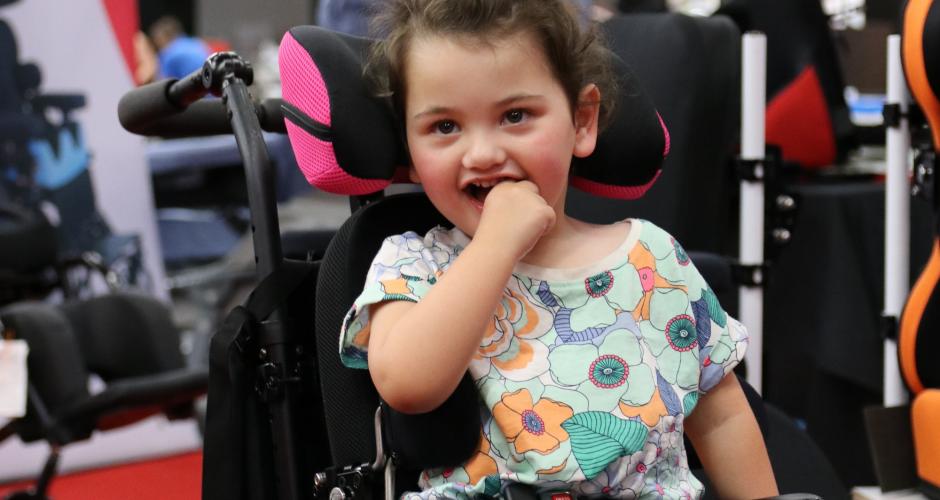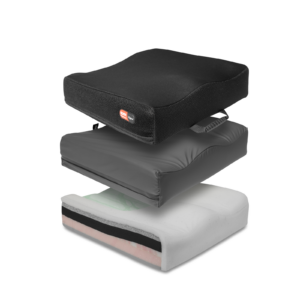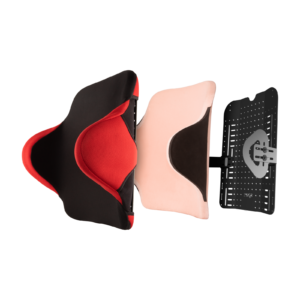Bridget Churchill explains how Spex Seating can adapt for those with Multiple Sclerosis (MS).
An article written and compiled by Bridget Churchill.
Multiple Sclerosis (MS) is a progressive autoimmune disorder that affects neural pathways within the brain and spinal cord. The body’s immune system mistakenly attacks the myelin, which surrounds nerve fibres to enable messages to travel smoothly between the brain and the rest of the body. The nerve fibres can also become damaged which can increase the experienced disability as the condition progresses. This results in messages being slowed down, distorted or blocked from reaching their destination.
MS affects people differently and symptoms can vary. Common difficulties include reduced balance and falls, fatigue, pain, spasticity, continence difficulties, low mood, somatosensory changes and cognitive dysfunction. The neural system is responsible for all the body functions, including mobility and cognition (memory and thinking). Cognition is also required for postural control, with more difficult postural management being more cognitively effortful (Fenstein, 2015).
Women are affected more than men. Children and teenagers can also experience MS. The MS Society identifies that 5-10% of people may experience their first symptoms of MS before the age of 16
Most individuals with MS will not require a wheelchair in the early stages of the condition, however about 80% of individuals with MS will require mobility assistive devices 10-15 years since disease onset, which includes the use of a wheelchair. Souza et al. (2010) found that manual wheelchairs were found to be the most common assistive mobility devices, including as a back-up mobility device. Some users may be users reported feeling embarrassed by the need for a mobility device, yet having an appropriate mobility device such as a powered wheelchair in later stages has also positively influenced quality of life and reintegration into activities (LaRocca, 2015; Souza et al., 2010) Mobility has a significant impact on quality of life and loss of mobility affects both the person with MS and their carers/family members.
Considerations for wheelchairs need to include the following:
- Optimal comfort and ease of use to minimise fatigue, appropriate to current and changing need.
- Minimise embarrassment of the user and optimise maintaining of self-identity.
- Include tilt-in-space options for supporting with pressure management as the condition progresses.
- Be the interface between the person and performing their chosen activities.
When considering seating provision for individuals, the key elements need to include:
- Supporting the body to maintain a healthy alignment against gravity at the hips, trunk, and head.
- Adequately supporting the pelvis and trunk to provide stability and allow movement of the head and limbs.
- Providing appropriate pressure relief and comfort.
- Providing support to minimise fatigue.
- Facilitating engagement in functional activities.
- Allow for adjustment and adaptation as needs change.
- Be easy to use by client and family/carers.
- Be aesthetically pleasing and allow for self-expression.
- Optimise posture for cardiac, respiratory and gastrointestinal function.
- Be able to transition between manual and powered wheelchair frames depending on chair chassis required.
Spex seating is a versatile, adjustable modular seating system that can be fixed onto almost any wheelchair chassis. It can be fitted to manual folding chairs and removed for easy transportation, as well as to powered chairs. The adult seating technology ranges can be adjusted to adapt to the users’ needs as they grow and experience changing needs.
The seating options include simple options to optimise comfort, as well as more immersive and shaped options to accommodate the need for additional stability and postural support. Spex is customisable to reflect personal colour choice, quick to adjust and modular to provide the right support when needed. Users only need order what they need and can add/remove components as their condition changes.
Spex shapes better lives and never overshadows the user!
Spex for kids and adults is a modular seating technology system which allows for easy adjustment and contouring for those with minimal to complex postural presentations. Products are customisable and can allow for rapid response to sequelae of stroke, such as hip fractures, muscle tone changes and range of movement changes at the joints.
Items can be used in isolation or as a full seating system on their chosen wheelchair chassis base. Seating technology products can be set up during the assessment ready for immediate use by the user and can usually be fitted directly to an existing wheelchair chassis if the user already has one.
The Spex seat pan and back rest shell can be removed if the wheelchair and seating system needs to be transported in a vehicle (e.g. if fitted to a folding manual wheelchair).
Adjustments do not require specialist wheelchair clinics but can be done by locally trained therapists to optimise comfort and postural responsiveness to the users’ needs.
All cushions include both an incontinence cover and a fabric breathable layer. All cushions have an inherent Velcro fabric over the base to securely fix onto seat pans. Increased shaping allows for improved stability, reduced effort to sit to reduce fatigue, management of asymmetry and comfort for the user, and to support pressure management needs.
Spex Trunk, Hip and Medial Knee/Thigh Supports and Accessories
The Spex lateral trunk supports, hip and medial thigh/knee supports include patented axial technology that can respond to the user’s unique postural presentation and need. There are various sizes to suit individual need.
The configuration can be adjusted to promote safety with transfers as there are various mounting systems to suit independent, assisted and dependent transfer methods and to reduce any falls risks associated with them.
There is a range of pelvic support belts and thoracic support harnesses to optimise stability, posture and position within the
seating system.
The height-adjustable shell option incorporates inbuilt growth adjustment in the back support due to the upper sliding interface. 
 The Spex Vigour back supports offer lighter-weight options for the more active wheelchair users. They are easily removed for wheelchair transportation.
The Spex Vigour back supports offer lighter-weight options for the more active wheelchair users. They are easily removed for wheelchair transportation.
The uphostery and covers allow good air flow for daily comfort.
The Spex Manta back support provides lateral trunk support and allows increased stability and support. It supports those with trunk weakness and can reduce side-ways leaning.
Shaping within these back suppports is possible with the Spex Tesselated Positioning Kit and this kit can also potentially be used under other flat foam cushions to provide increased contouring.
The more supportive Spex and Spex SuperShape are versatile back supports that respond quickly (with easy adjustment) to more complex postural changes including posterior pelvic tilt or obliquity, spinal scoliosis.
These back supports allow for greater immersion, pressure redistribution and support for those with marked asymmetry and complexity.
|
Shaping within these back suppports is possible with the Spex Tesselated Positioning Kit and this kit can also potentially be used under other flat foam cushions to provide increased contouring.
The more supportive Spex and Spex SuperShape are versatile back supports that respond quickly (with easy adjustment) to more complex postural changes including posterior pelvic tilt or obliquity, spinal scoliosis.
These back supports allow for greater immersion, pressure redistribution and support for those with marked asymmetry and complexity.
The Spex head support range provides support in several different positions to provide optimal head alignment to encourage interaction, manage fatigue and pain and promote continued engagement in activities.
The range includes the basic compact head support for users with good head control, the square head support, the contoured and the adjustable lateral head support for the more dependent user.
Contact us to:
- Arrange clinical education on our products in your venue of choice, or
- Obtain information about your local dealer for sales enquiries if outside of New Zealand & Australia.
Feinstein, A., Freeman, J., & Lo, A. C. (2015). Treatment of progressive multiple sclerosis: What works, what does not, and what is needed. The Lancet Neurology, 14(2), 194-207. http://dx.doi.org/10.1016/S1474-4422(14)70231-5
Giannì, C., Prosperini, L., Jonsdottir, J., & Cattaneo, D. (2014). A systematic review
of factors associated with accidental falls in people with multiple sclerosis:
A meta-analytic approach. Clinical Rehabilitation, 28(7), 704-716.
http://dx.doi.org/10.1177/0269215513517575
MS Society. (n.d.). What is MS? From https://www.mssociety.org.uk/about-ms/what-is-ms
LaRocca, N. G. (2011). Impact of walking impairment in multiple sclerosis. The Patient,
4(3), 189-201. http://dx.doi.org/10.2165/11591150-000000000-00000
Souza, A., Kelleher, A., Cooper, R., Cooper, R. A., Iezzoni, L. I., & Collins, D. M. (2010). Multiple sclerosis and mobility-related assistive technology: Systematic review of
literature. The Journal of Rehabilitation Research and Development, 47(3), 213.
https://doi.org/10.1682/JRRD.2009.07.0096



















